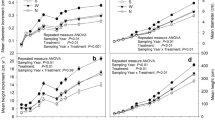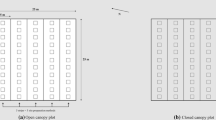Abstract
We studied three hybrid poplar plantations in Quebec (Canada) established on sites with varying soil and environmental characteristics to investigate the effects of logging residues on the water potential, carbon isotope ratio and foliar nutrients of planted trees. On each site, four treatments representing different residue loads, as well as treatments aimed at manipulating specific factors of the environment (Herbicide, Geotextile) were applied to test their effects on seedling water potential, carbon isotope ratio and foliar nutrients. Along with analyses of variance, we used structural equation modelling to infer causal relationships of logging residues on height, basal diameter and foliar nutrition of trees through their effects on soil temperature, soil water content and competing vegetation cover. Logging residues decreased soil temperature at all sites and woody plants cover at one site out of three. Height, basal diameter and unit leaf mass were strongly related to each other. Foliar δ13C, N concentration and unit leaf mass increased with decreasing cover of woody plants suggesting an important role of competition for resources. Overall, logging residues had no direct influence on hybrid poplar dimensions after two growing seasons: their effects on the microenvironment of this resource demanding tree species were either cancelling out each other, or were not significant enough to have a significant impact on the growth drivers measured. For example, presence of logging residues might reduce soil temperature, impeding overall seedling performance. Our study highlights the fact that any given silvicultural method aimed at manipulating logging residues has a complex influence involving the interaction of multiple environmental drivers and that the net effect on tree productivity will depend on species and site specific conditions.

Similar content being viewed by others
References
Achat D, Deleuze C, Landmann G, Pousse N, Ranger J, Augusto L (2015) Quantifying consequences of removing harvesting residues on forest soils and tree growth—a meta-analysis. For Ecol Manag 348:124–141
Buitrago M, Paquette A, Thiffault N, Bélanger N, Messier C (2015) Early performance of planted hybrid larch: effects of mechanical site preparation and planting depth. New Forest 46(3):319–337. doi:10.1007/s11056-014-9463-3
Byrnes J (2012) Model averaging. http://jarrettbyrnes.info/ubc_sem/lavaan_materials/lavaan.modavg.R. Accessed 13 Oct 2013
Chapin FS III, Van Cleve K, Tryon P (1986) Relationship of ion absorption to growth rate in taiga trees. Oecologia 69(2):238–242. doi:10.1007/BF00377628
Duursma RA, Marshall JD (2006) Vertical canopy gradients in δ13C correspond with leaf nitrogen content in a mixed-species conifer forest. Trees 20(4):496–506. doi:10.1007/s00468-006-0065-3
Egnell G (2011) Is the productivity decline in Norway spruce following whole-tree harvesting in the final felling in boreal Sweden permanent or temporary? For Ecol Manag 261(1):148–153. doi:10.1016/j.foreco.2010.09.045
Environment Canada (2012) National climate data and information archive. http://climate.weatheroffice.gc.ca/. Accessed 18 June 2012
Farquhar GD, Ehleringer JR, Hubick KT (1989) Carbon isotope discrimination and photosynthesis. Annu Rev Plant Physiol Plant Mol Biol 40(1):503–537. doi:10.1146/annurev.pp.40.060189.002443
Hansen EA, McLaughlin RA, Pope PE (1988) Biomass and nitrogen dynamics of hybrid poplar on two different soils: implications for fertilization strategy. Can J For Res 18(2):223–230. doi:10.1139/x88-033
Harrington TB, Slesak RA, Schoenholtz SH (2013) Variation in logging debris cover influences competitor abundance, resource availability, and early growth of planted Douglas-fir. For Ecol Manag 296:41–52
Hershberger S, Marcoulides G, Parramore M (2003) Structural equation modeling: an introduction. In: Pugesek B, Tomer A, Eye AV (eds) Structural equation modeling: applications in ecological and evolutionary biology. Cambridge University Press, Cambridge, pp 3–41
Kaelke CM, Kruger EL, Reich PB (2001) Trade-offs in seedling survival, growth, and physiology among hardwood species of contrasting successional status along a light-availability gradient. Can J For Res 31(9):1602–1616. doi:10.1139/x01-090
Kazda M, Salzer J, Schmid I, Von Wrangell P (2004) Importance of mineral nutrition for photosynthesis and growth of Quercus petraea, Fagus sylvatica and Acer pseudoplatanus planted under Norway spruce canopy. Plant Soil 264(1–2):25–34. doi:10.1023/B:PLSO.0000047715.95176.63
Kranabetter JM, Simard SW, Guy RD, Coates KD (2010) Species patterns in foliar nitrogen concentration, nitrogen content and 13C abundance for understory saplings across light gradients. Plant Soil 327(1–2):389–401. doi:10.1007/s11104-009-0062-6
Lambert MC, Ung CH, Raulier F (2005) Canadian national tree aboveground biomass equations. Can J For Res 35(8):1996–2018. doi:10.1139/x05-112
Landhäusser SM, DesRochers A, Lieffers VJ (2001) A comparison of growth and physiology in Picea glauca and Populus tremuloides at different soil temperatures. Can J For Res 31(11):1922–1929. doi:10.1139/x01-129
Lei P-W, Wu Q (2007) Introduction to structural equation modeling: issues and practical considerations. Educ Meas Issues Pract 26(3):33–43. doi:10.1111/j.1745-3992.2007.00099.x
Mamashita T, Larocque GR, DesRochers A, Beaulieu J, Thomas BR, Mosseler A, Major J, Sidders D (2015) Short-term growth and morphological responses to nitrogen availability and plant density in hybrid poplars and willows. Biomass Bioenergy 81:88–97. doi:10.1016/j.biombioe.2015.06.003
Mazerolle MJ (2013) AICcmodavg: model selection and multimodel inference based on (Q)AIC(c), R package version 1.29 R Foundation for Statistical Computing, Vienna, Austria
Peng YY, Dang Q-L (2003) Effects of soil temperature on biomass production and allocation in seedlings of four boreal tree species. For Ecol Manag 180(1–3):1–9. doi:10.1016/S0378-1127(02)00486-3
Périnet P, Caron F, Fauchon A (2010) Liste des clones recommandés de peuplier hybride selon les sous-régions écologiques du Québec (mise à jour octobre 2010). Ministère des Ressources naturelles et de la Faune du Québec, Direction de la Recherche Forestière
Pothier D, Savard F (1998) Actualisation des tables de production pour les principales espèces du Québec. Gouvernement du Québec, ministère des Ressources naturelles, Bibliothèque nationale du Québec
Proe MF, Dutch J (1994) Ameliorative practices for restoring and maintaining Impact of whole-tree harvesting on second-rotation growth of Sitka spruce: the first 10 years. For Ecol Manag 66(1):39–54. doi:10.1016/0378-1127(94)90147-3
Proe MF, Griffiths JH, McKay HM (2001) Effect of whole-tree harvesting on microclimate during establishment of second rotation forestry. Agric For Meteorol 110(2):141–154. doi:10.1016/S0168-1923(01)00285-4
Pugesek B, Tomer A, von Eye A (eds) (2003) Structural equation modeling: applications in ecological and evolutionary biology. Cambridge University Press, Cambridge
R Core Team (2013) R: a language and environment for statistical computing. R Foundation for Statistical Computing, Vienna, Austria
Raven P, Evert R, Eichhorn S (2005) Biology of plants, 7th edn. W. H. Freeman and Company Publishers, New York
Reich PB, Tjoelker MG, Walters MB, Vanderklein DW, Buschena C (1998a) Close association of RGR, leaf and root morphology, seed mass and shade tolerance in seedlings of nine boreal tree species grown in high and low light. Funct Ecol 12(3):327–338. doi:10.1046/j.1365-2435.1998.00208.x
Reich PB, Walters MB, Tjoelker MG, Vanderklein D, Buschena C (1998b) Photosynthesis and respiration rates depend on leaf and root morphology and nitrogen concentration in nine boreal tree species differing in relative growth rate. Funct Ecol 12(3):395–405. doi:10.1046/j.1365-2435.1998.00209.x
Ritchie GA, Hinckley TM (1975) The pressure chamber as an instrument for ecological research. Adv Ecol Res 9:165–254
Roberts SD, Harrington CA, Terry TA (2005) Harvest residue and competing vegetation affect soil moisture, soil temperature, N availability, and Douglas-fir seedling growth. For Ecol Manag 205(1–3):333–350. doi:10.1016/j.foreco.2004.10.036
Rosseel Y (2012) lavaan: an R package for structural equation modeling. J Stat Softw 48(2):1–36
Saucier J, Robitaille A, Grondin P (2009) Cadre bioclimatique du Québec. Manuel de foresterie, 2nd edn. Ordre des ingénieurs forestiers du Québec, Éditions Multimondes, Québec, pp 186–205
Shipley B (2016) Cause and correlation in biology: a user’s guide to path analysis, structural equations and causal inference, 2nd edn. Cambridge University Press, Cambridge
Smolander A, Saarsalmi A, Tamminen P (2015) Response of soil nutrient content, organic matter characteristics and growth of pine and spruce seedlings to logging residues. For Ecol Manag 357:117–125. doi:10.1016/j.foreco.2015.07.019
Soil Classification Working Group (1998) The Canadian system of soil classification, 3rd edn. NRC Research Press, Ottawa
Stettler R, Bradshaw T, Heilman P, Hinckley T (1996) Biology of populus and its implications for management and conservation. NRC Research Press. doi:10.1139/9780660165066
Stevens PA, Hornung M (1990) Effect of harvest intensity and ground flora establishment on inorganic-N leaching from a Sitka spruce plantation in north Wales, UK. Biogeochemistry 10(1):53–65. doi:10.1007/BF00000892
Thiffault E, Hannam KD, Paré D, Titus BD, Hazlett PW, Maynard DG, Brais S (2011) Effects of forest biomass harvesting on soil productivity in boreal and temperate forests—a review. Environ Rev 19(NA):278–309
Tomer A, Pugesek BH (2003) Guidelines for the implementation and publication of structural equation models. In: Pugesek B, Tomer A, vonEye A (eds) Structural equation modeling: applications in ecological and evolutionary biology. Cambridge University Press, New York, pp 125–140
Trottier-Picard A, Thiffault E, DesRochers A, Paré D, Thiffault N, Messier C (2014) Amounts of logging residues affect planting microsites: a manipulative study across northern forest ecosystems. For Ecol Manage 312:203–215
Vandenberg RJ, Lance CE (2000) A review and synthesis of the measurement invariance literature: suggestions, practices, and recommendations for Organizational Research. Organ Res Methods 3(1):4–70
Warnes GR, Bolker B, Lumley T, Johnson RC (2013) gmodels: various R programming tools for model fitting, R package version 2.16.2. R Foundation for Statistical Computing, Vienna, Austria
Zabowski D, Java B, Scherer G, Everett RL, Ottmar R (2000) Timber harvesting residue treatment: part 1. Responses of conifer seedlings, soils and microclimate. For Ecol Manage 126(1):25–34. doi:10.1016/S0378-1127(99)00081-X
Acknowledgments
We thank Sébastien Dagnault, Jacques Morissette, Fanny Michaud and William McGuire for field work, Serge Rousseau for laboratory analyses, and Dr. Marc J. Mazerolle and Dr. Bill Shipley for their assistance with statistical analyses. The Natural Sciences and Engineering Research Council of Canada and the Fonds de recherche du Québec—Nature et Technologie provided scholarships to ATP. We also acknowledge our industrial partners Domtar, Louisiana Pacific (Chambord OSB), and Norampac. The FRQNT and the Canadian Forest Service of Natural Resources Canada provided funding for the project.
Author information
Authors and Affiliations
Corresponding author
Electronic supplementary material
Below is the link to the electronic supplementary material.
Rights and permissions
About this article
Cite this article
Trottier-Picard, A., Thiffault, E., Thiffault, N. et al. Complex impacts of logging residues on planted hybrid poplar seedlings in boreal ecosystems. New Forests 47, 877–895 (2016). https://doi.org/10.1007/s11056-016-9550-8
Received:
Accepted:
Published:
Issue Date:
DOI: https://doi.org/10.1007/s11056-016-9550-8




